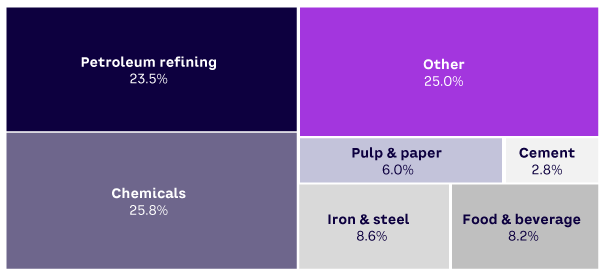Around the world, efforts are increasing to drastically reduce greenhouse gas (GHG) emissions by 2050. The goal of the Paris Agreement is to hold the increase in global average temperature rise to below 2°C as compared with preindustrial levels, specifically aiming to limit it to 1.5°C. As of 2017, the global average temperature rise reached approximately 1°C. It is expected to hit the 1.5°C mark by 2040 if current trends continue. Limiting temperature rise to 2°C will require reaching net zero emissions in the latter half of the 21st century; GHG emissions would need to reach a near-zero value by 2050 to limit the rise to 1.5°C.
The industrial sector represents a significant source of energy-related GHG emissions. For instance, in the US, it accounted for 33% of overall primary energy use in 2020 and was responsible for 30% of the nation’s total energy-related GHG emissions (see Figure 1). Reducing a sizeable portion of these emissions will play a key role in achieving the Paris Agreement’s goals.
![Figure 1. Carbon emissions and primary energy use by sector, 2020 (source: US Energy Information Administration [EIA])](/sites/default/files/Amplify/2023/amp2311_oakridge_F01_0.png)
The focus of industrial decarbonization is on the energy-related CO2 emissions from fossil fuel combustion and specific processes since they constitute the largest portion of industrial GHG emissions. Other GHGs, such as CH4 and N2O, have higher global-warming potential and should be reduced as well, but they are comparatively less in amount.
As of 2021, manufacturing was responsible for almost three-quarters of all industrial GHG emissions in the US. The bulk of manufacturing energy-related CO2 emissions comes from iron and steel, chemicals, food and beverage, petroleum refining, pulp and paper, and cement (see Figure 2). Decarbonization efforts should therefore focus on these industries.

[For more from the authors on this topic, see: “Efficiency’s Role in Industrial Decarbonization.”]







